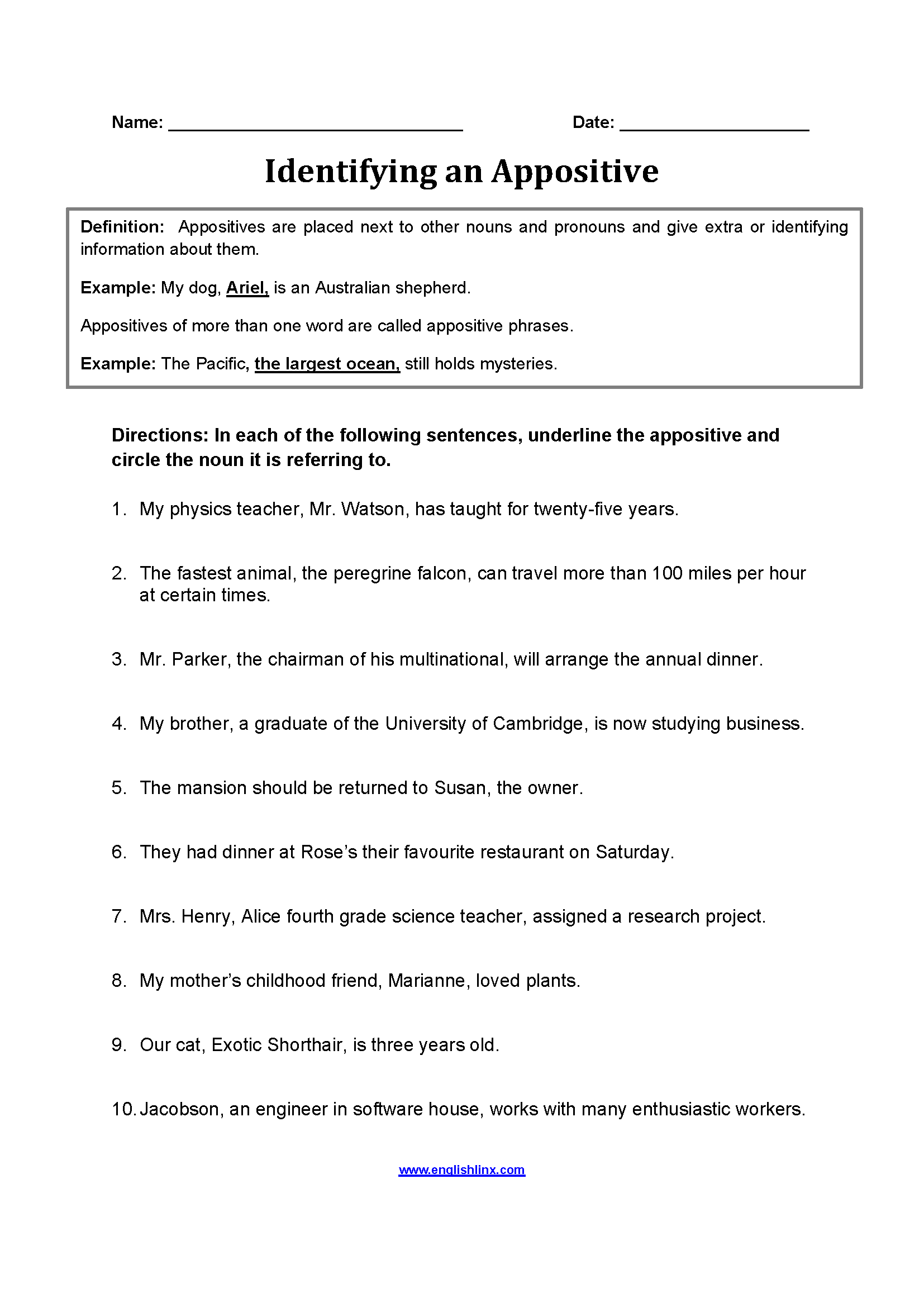
Unlocking Grammatical Precision: The Indispensable Role of Appositives Worksheets
In the vast and intricate landscape of the English language, mastering grammatical structures is paramount for clear, concise, and impactful communication. Among the many elements that contribute to sophisticated writing, appositives stand out as powerful tools for adding detail, clarity, and elegance to sentences. An appositive, essentially a noun or noun phrase that renames or clarifies another noun right beside it, can transform rudimentary sentences into rich, informative statements. However, grasping the nuances of appositives – particularly their punctuation – often proves challenging for learners. This is where appositives worksheets emerge as an indispensable resource, offering structured practice that leads to genuine mastery.
This comprehensive article will delve into the nature of appositives, their significance in writing, and most importantly, explore why appositives worksheets are not just helpful, but absolutely essential for anyone looking to refine their grammatical precision and elevate their writing style.
What Exactly Are Appositives?
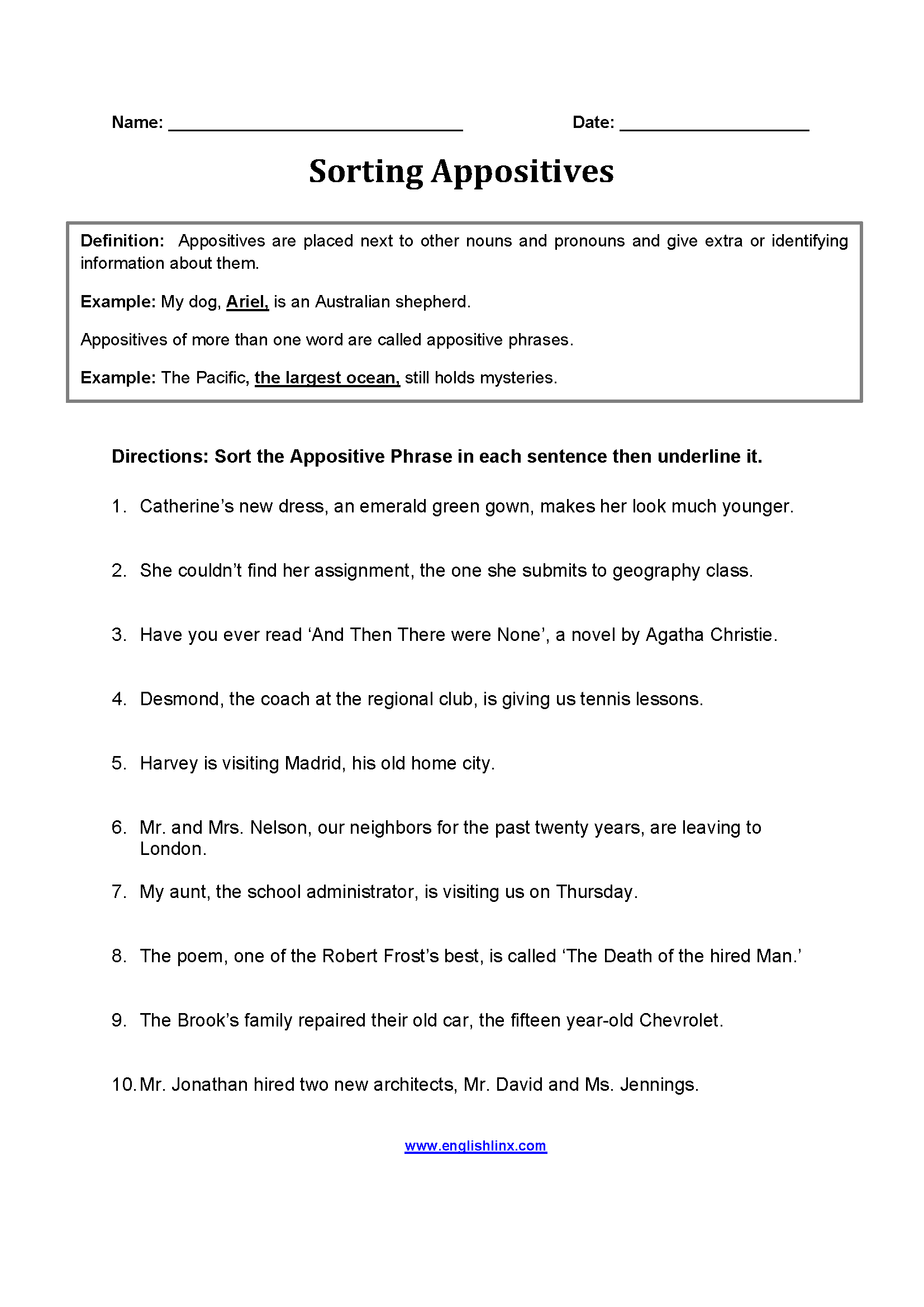
At its core, an appositive is a noun or a noun phrase that sits next to another noun or pronoun and provides additional information about it. It acts like a second name or a brief description, adding context without the need for a separate clause.
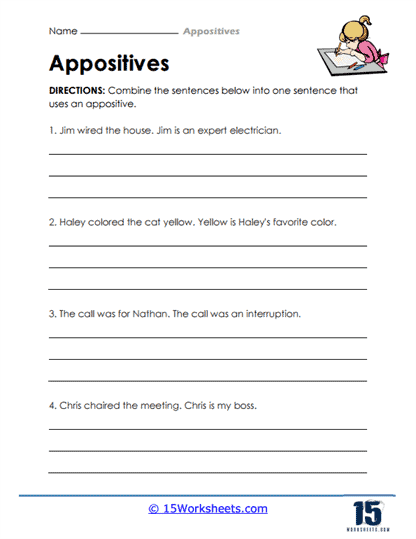
Consider these examples:

- "My brother, a talented musician, plays the guitar." (Here, "a talented musician" renames "My brother.")
- "We visited Rome, the Eternal City." ("the Eternal City" renames "Rome.")
- "The dog, a golden retriever with a wagging tail, greeted us warmly." ("a golden retriever with a wagging tail" describes "The dog.")

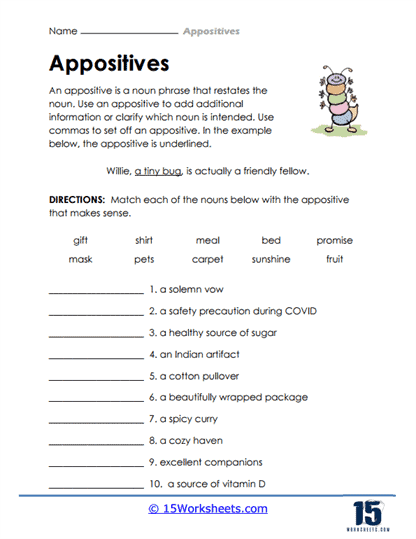
Appositives enhance sentences by embedding extra information smoothly, avoiding choppiness that might result from using multiple short sentences or complex clauses. They allow writers to convey more information within a single, cohesive thought.
The Two Faces of Appositives: Restrictive vs. Non-Restrictive
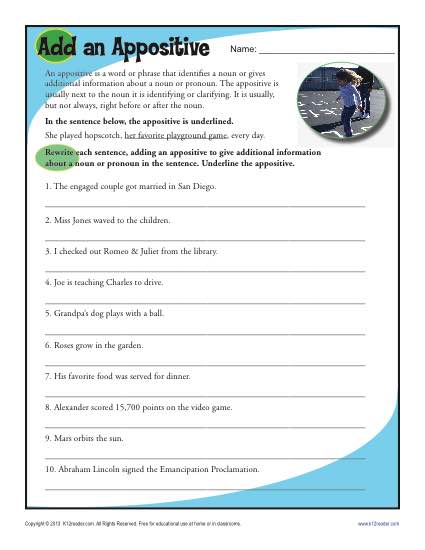
Understanding appositives hinges significantly on distinguishing between their two main types: restrictive and non-restrictive. This distinction dictates the crucial aspect of punctuation – specifically, the use of commas.
-
Non-Restrictive (Non-Essential) Appositives:
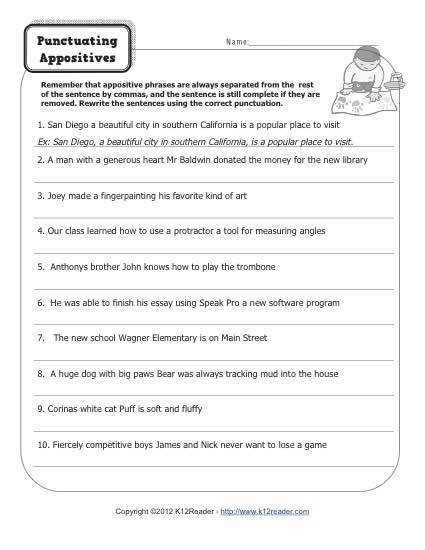
- These appositives provide extra, non-essential information. The sentence’s meaning would remain clear even if the appositive were removed.
- They are set off by commas (or dashes/parentheses) because they represent an interruption or an aside.
- Example: "Dr. Eleanor Vance, a renowned astrophysicist, delivered the keynote address." (You could remove "a renowned astrophysicist," and we’d still know Dr. Vance delivered the address. The appositive simply adds more detail about her.)
- More examples:
- "My car, a vintage Volkswagen Beetle, often breaks down."
- "Paris, the capital of France, is famous for its art and cuisine."

-
Restrictive (Essential) Appositives:
- These appositives provide essential information that is necessary to identify or clarify the noun they modify. If you remove a restrictive appositive, the meaning of the sentence would change or become unclear.
- They are not set off by commas.
- Example: "My friend John is visiting next week." (If you have multiple friends, "John" is essential to specify which friend. Removing "John" would make the sentence ambiguous: "My friend is visiting next week.")
- More examples:
- "The novel ‘Moby Dick’ is a classic of American literature." (The title is essential to identify which novel.)
- "My sister Sarah lives in London." (If you have more than one sister, "Sarah" specifies which one.)

The correct application of commas with appositives is a frequent source of error, and it’s precisely this area where appositives worksheets prove their immense value. They offer targeted exercises designed to reinforce this critical punctuation rule.
Why Mastering Appositives Matters for Effective Writing
Beyond simply adhering to grammatical rules, the skillful use of appositives offers significant benefits to a writer:
- Clarity and Precision: Appositives allow for precise identification or description without making sentences overly long or convoluted. They help avoid ambiguity.
- Sentence Variety and Sophistication: Incorporating appositives breaks up the monotony of simple subject-verb-object structures, creating more dynamic and mature prose. They contribute to a more advanced writing style.
- Conciseness: Instead of using a separate clause ("who is a talented musician"), an appositive condenses information, making sentences more efficient ("a talented musician").
- Enhanced Description: They provide a compact way to add rich, descriptive details directly where they are most relevant, painting a clearer picture for the reader.
The Indispensable Role of Appositives Worksheets
For effective learning and mastery, appositives worksheets stand out as particularly effective. They provide the structured, repetitive, and varied practice necessary to internalize the rules and apply them confidently. Here’s why they are so crucial:
- Identification Practice: Many worksheets start with basic identification exercises. Students are given sentences and asked to underline or circle the appositive. This foundational step helps learners recognize what an appositive looks like in context before they move on to more complex tasks.
- Punctuation Mastery: This is arguably the most critical area where worksheets shine. Exercises specifically focus on whether to use commas or not, forcing students to apply the restrictive vs. non-restrictive rule repeatedly.
- Example Activity: "Add commas where necessary: ‘My dog Fido loves to chase squirrels.’ ‘My neighbor Mr. Henderson is a retired teacher.’"
- Construction and Application: Beyond identification, appositives worksheets challenge students to actively construct sentences using appositives. This could involve combining two simple sentences into one using an appositive, or writing original sentences based on prompts.
- Example Activity: "Combine these sentences using an appositive: ‘Maria is an excellent baker. She made the cake.’ -> ‘Maria, an excellent baker, made the cake.’"
- Example Activity: "Write a sentence using an appositive to describe your favorite food."
- Error Correction: Worksheets often include sentences with incorrect appositive usage or punctuation. Students must identify the error and correct it, sharpening their critical eye and reinforcing the rules.
- Reinforcement through Repetition: Grammar concepts are not typically mastered through a single explanation. They require consistent exposure and practice. Worksheets provide the perfect platform for this necessary repetition, solidifying understanding over time.
- Self-Assessment and Immediate Feedback: Many appositives worksheets come with answer keys, allowing students to check their work immediately. This instant feedback loop is invaluable for self-directed learning, enabling students to understand where they went wrong and correct their misconceptions on the spot.
- Addressing Common Pitfalls: Learners frequently struggle with the comma rule, confusing appositives with other modifying phrases, or misplacing them. Worksheets are designed to specifically target these common areas of difficulty through focused drills. For instance, exercises might juxtapose appositives with participial phrases to highlight the differences.
Varieties of Appositives Worksheets
The effectiveness of these learning tools lies in their diverse formats, catering to different learning styles and progressive skill development:
- Underline/Circle the Appositive: Basic identification.
- Add Commas: Focus specifically on punctuation rules for non-restrictive appositives.
- Combine Sentences: Challenges students to transform simple sentences into more complex ones using appositives, fostering stylistic improvement.
- Write Your Own: Encourages creative application and deep understanding.
- Multiple Choice: Tests understanding of definitions and correct usage in various contexts.
- Fill-in-the-Blanks: Provides context and asks students to supply an appropriate appositive.
- Proofreading Passages: Students identify and correct appositive errors within a larger text, simulating real-world editing.
The very design of appositives worksheets caters to this need for repetition and varied exposure, ensuring that students encounter the concept in multiple forms and contexts.
Integrating Worksheets into the Learning Process
Appositives worksheets are versatile and can be integrated into various educational settings:
- Classroom Instruction: Teachers can use them as in-class practice, homework assignments, or diagnostic tools to assess prior knowledge. Group work on worksheets can also foster collaborative learning and discussion.
- Self-Study: For independent learners, online resources and grammar textbooks often provide printable or interactive appositives worksheets, complete with explanations and answer keys.
- Remediation and Enrichment: Students struggling with appositives can benefit from targeted remedial worksheets, while advanced learners can tackle more complex exercises involving longer appositive phrases or subtle distinctions.
In confronting these common pitfalls, well-designed appositives worksheets offer a structured and systematic approach, breaking down the learning process into manageable steps. They transform what might seem like an abstract grammatical rule into a series of concrete, actionable exercises.
Beyond the Worksheet: Applying Appositives in Real Writing
While worksheets are foundational, true mastery of appositives, like any grammatical concept, culminates in their effective application in actual writing. Students should be encouraged to:
- Read Actively: Pay attention to how professional writers use appositives in books, articles, and essays. Identify them and analyze their effect on the sentence.
- Write Consistently: Consciously try to incorporate appositives into their own essays, reports, and creative writing.
- Seek Feedback: Have their writing reviewed by peers or instructors, specifically asking for feedback on their use of appositives and punctuation.
Worksheets provide the muscle memory; real writing provides the opportunity to perform.
Conclusion
Appositives are powerful linguistic tools that inject clarity, conciseness, and sophistication into written English. Their proper use, particularly the correct application of punctuation, is a hallmark of skilled writing. The journey to mastering this nuanced grammatical element is significantly facilitated, if not made possible, by the diligent and varied use of appositives worksheets.
From basic identification to complex sentence construction and error correction, these worksheets provide the essential practice, repetition, and targeted feedback necessary for learners to confidently identify, punctuate, and skillfully employ appositives in their own communication. In an educational landscape that values both foundational knowledge and practical application, appositives worksheets remain an indispensable resource, guiding students towards greater grammatical precision and, ultimately, more effective and elegant writing.
